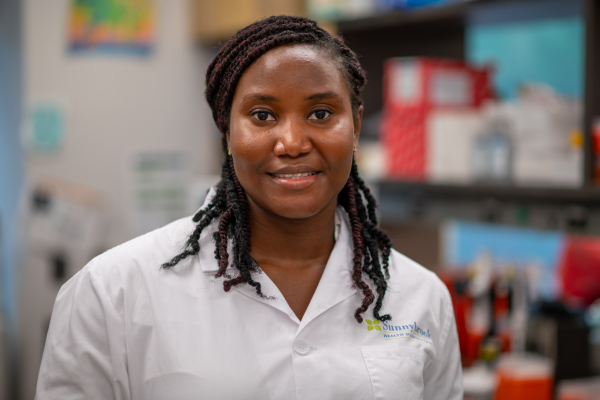Temerty Medicine PhD candidate investigates non-invasive gene therapy approaches to treat Alzheimer’s disease


An estimated 750,000 people live with Alzheimer’s disease or another form of dementia in Canada. With no cure for the disease and a growing aging population, effective treatments still need to be established to manage the progression of Alzheimer’s and other age-related neurodegenerative disorders.
Gene therapy is a hopeful avenue to improve cognitive function and slow the progression of the disease – but there are still many scientific advances needed to efficiently and safely deliver it to the brain.
Chinaza Dibia, a PhD candidate at the Temerty Faculty of Medicine, is working to improve non-invasive gene delivery methods to slow the progression of Alzheimer’s disease in its early stages.
Under the supervision of Isabelle Aubert, a professor at Temerty Medicine and senior scientist at the Sunnybrook Research Institute, Dibia is one of several researchers in Aubert’s lab investigating non-invasive approaches to treat brain regions affected by Alzheimer’s disease using gene therapy and another developing method, called focused ultrasound.
“Several immunotherapies have failed to slow the progression of the disease, and this could be the result of poor penetration into the brain,” Dibia says.
“My research goal is to develop a non-invasive, regulated gene therapy approach for Alzheimer’s disease which has a high expression of therapeutic genes in brain regions when and where it is most needed.”
Reaching the depths of the brain
Less than one per cent of most therapeutics bypass the blood-brain barrier when injected into the bloodstream, which makes getting past it a crucial part of delivering treatment to brain areas such as the cortex and hippocampus, brain regions involved in memory and learning.
Think of the blood-brain barrier as another level of protection for the brain. Made of tissues and cells, the barrier stops harmful toxins from reaching the brain. While this is a protective function, it makes it difficult to deliver medications and treat brain-related diseases.
In 2017, scientists at Sunnybrook made history when they successfully used low-intensity focused ultrasound in a clinical trial to safely and non-invasively modulate the blood-brain barrier in six patients with Alzheimer’s disease.
To temporarily open the barrier, focused ultrasound waves are guided by magnetic resonance imaging (MRI). When the ultrasound waves interact with microbubbles – tiny gas-filled bubbles injected through an IV and circulated in the bloodstream – the bubbles vibrate within the blood vessels, which change the properties of the barrier between the blood and the brain.
From the moment of the ultrasound-microbubbles interaction, therapeutics administered in the blood can reach the brain for up to four to 12 hours, after which the properties of the barrier are restored.
For gene therapy applications, gene carriers are delivered in the blood and enter the brain in regions targeted with MRI-guided focused ultrasound. The carriers then deliver the gene of interest to the brain cells, transforming them into mini-factories capable of producing therapeutics in a controlled manner.
“Focused ultrasound gene delivery is at the cusp of its potential,” says Aubert, a Tier 1 Canada Research Chair in Brain Repair and Regeneration. “A current unmet need in the field that researchers in the Aubert Lab and beyond are tackling is the non-invasive delivery of genes to the brain. Focused ultrasound offers a non-surgical approach to fulfill this need.”
“A one-time non-invasive gene delivery to the brain to produce therapeutics for decades is something that we envision.”
Repairing the brain with gene therapy
Gene therapy helps the body battle a disease and, in this case, could support the long-term production of therapeutics in the brain.
The potential of therapeutics comes down to three key functions: to tailor it to a patient’s genetics; to reduce pathology common in Alzheimer’s; and to promote regeneration, resilience and cell survival for brain health.
While some immunotherapies target amyloid plaque, a characteristic of Alzheimer’s disease, Dibia is focused on early intervention and regulation of therapeutics. The right gene delivery method could help prevent the progression of the disease in the first place, Dibia says.
Dibia is utilizing gene producing an antibody against anti-amyloid beta. Anti-amyloid antibodies and focused ultrasound have shown to be a safe for Alzheimer’s patients.
A 2024 article from The New England Journal of Medicine outlined that the use of anti-amyloid beta antibodies, coupled with focused ultrasound, significantly reduced amyloid plaque six months post-treatment. The study involved three patients who had been diagnosed with Alzheimer’s a year before treatment.

For her gene delivery approach, Dibia is exploring the use of a promoter – called the glial fibrillary acidic protein promoter (GFAP) – that will drive the expression of the therapeutic antibody in glial cells of the brain, which are naturally designed to support the brain environment and the health of neuronal cells. This strategy aims to utilize the response of these glial cells to Alzheimer’s pathology. The reaction of glial cells to the accumulation of amyloid-beta peptides will trigger the gene to produce therapeutic antibodies.
This gene expression can be further enhanced, if needed, by brief exposures to focused ultrasound, which can temporarily increase the reactivity of glial cells.
The response of the GFAP promoter to endogenous pathology and external control, such as focused ultrasound, makes this approach promising for the regulation of gene therapy to specific areas of the brain when they are most needed.
“By utilizing the glial promoter to increase the expression of the gene that we deliver, we can control the production of therapeutic antibodies in brain regions that are mostly affected by the disease,” Dibia says.
To carry therapeutic genetic material from the blood to the brain, Dibia is employing adeno-associated viruses (AAV), a vector technology that can cross the blood-brain barrier. There are several AAV serotypes used in gene therapy. The selection of AAV serotypes in gene therapy is dependent on specific brain regions and cell types targeted, as highlighted by a 2021 journal article.
Under the control of a glial promoter, the anti-amyloid beta therapeutic is encoded in the AAV (the vector). Once inside the brain, the vector delivers the therapeutic gene which can enter brain cells. Glial cells then produce the therapeutic antibodies, which is released in the brain environment to protect other brain cells, such as neurons.
As Dibia prepares to run analyses of her gene therapy approach, she says that the possibilities in innovation gives hope for the future of treatment.
“The future for Alzheimer’s disease treatment is promising,” Dibia says. “Research efforts offer hope in halting this disease or slowing the progression of the disease.”







